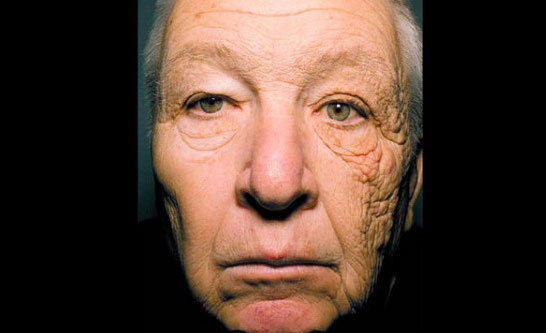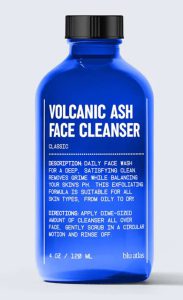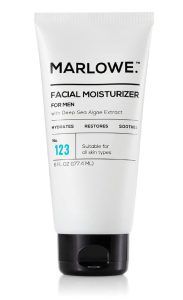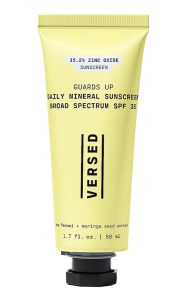By: Setareh Hamidi
Many men view skin care as bizarre and feminine due to the stigma attached to grooming and hair and skin care for men. To them, a skin routine is limited to sheet masks and cosmetics, of which there are so many these days. If you are a man or have men around you, this might sound familiar, which is why you should keep reading to learn how essential a skin routine is for men.
The general health and appearance of your skin is highly affected by your lifestyle and genetics, as well as environmental factors such as invisible waves, sunlight, and cold. The greatest damage incurred to skin is the effect of sunlight, or photoaging; a phenomenon that is undeniable in both men and women. As vital sunlight is for vitamin D absorption, excessive exposure can cause redness, skin discoloration, burn, increased wrinkles and skin spots, and higher risk of skin cancer. The following image, published by New England Journal of Medicine, illustrates the damage caused by sunlight to a 69-year-old truck driver’s skin, exposed to sunlight only from one side of the truck window.

⇑ (This photo from the New England Journal of Medicine shows the extreme photoaging of a 69-year-old truck driver whose left side sat exposed to Ultraviolet-A sun rays for more than 25 years. A team of Northwestern dermatologist and laser surgery experts are treating the patient in an effort to restore as much of his facial features as possible.)
When it comes to minimizing environmental and internal damage to skin, prevention is more effective than treatment. To do this, you need an efficient routine, which starts with identifying your skin type. Your skin can be dry, oily, normal, or combination. Dry skin appears opaque, lacks glow, is rough and makes people look older. However, oily skin has open pores and is glossy, soft, more prone to acne and oily in appearance. Combination skin is usually oily in the T-zone (forehead, nose, and chin), and dry in other regions. Finally, normal skin is neither too oily nor too dry, and is known as the most ideal type of skin. You can determine your skin type one hour after cleansing by touching or examining the appearance of your skin.
Now you can establish a routine that helps you tune up your complexion and have healthy skin. Read on for the stages of an easy-to-follow routine.
1.Cleanser
The first stage is a suitable cleanser, designed to remove makeup, dead cells, excessive oil, and contamination so that substances can penetrate the underlying layers and the following stages can have the necessary impact. Washing the skin twice a day (once in the morning and once at night) is enough for most people. It is important to avoid using hand soap or shampoo to wash your skin, as many men do, as they can irritate facial skin. Unless there is a special problem, choose a gentle cleanser to avoid dryness and loss of necessary moisture. For mixed skin, the cleanser should clear pores without causing dryness or sensitivity in dry parts.
To cleanse properly, apply some cleanser to wet skin with clean hands, and clean your entire face using circular motion. Repeat the motion on your forehead, cheeks, chin, and even neck. Be cautious about the parts around the mouth and eyes. Depending on the type of cleanser, different durations may be required for cleansing, though typically between 30 seconds and one minute should be enough. Rinse the skin with lukewarm or cool water, and dry gently with a clean towel using tapping motion. You should not drag the towel on your skin, nor should you apply pressure. For greater cleansing and adjustment of skin PH, you can use toner.
2.Moisturizer
Moisturizers help rehydrate skin, replace natural fats and proteins and keep the skin barrier intact despite cold, dry weather and hot showers that cause loss of moisture. Contrary to common belief, moisturizers are vital for all skin types, even oily ones. If moisturizers make you, like many other people, feel oily and heavy, pick one that is water-based and light weight and moisturize twice a day after cleansing your skin.
3.Skin treatment
No two people have the same exact skin, meaning each skin needs a specific treatment and no one-size-fits-all prescription can be given. That being said, one product that needs to be highlighted is retinoid, which was previously used for acne treatment and has recently shown antiaging effects. Retinoid reduces wrinkles and uneven pigmentation and promotes skin cell regeneration. Apply the size of a chickpea to the entire face on fully dry skin alongside moisturizer, beginning with once every other night and gradually increasing to every night.
You might see redness, sensitivity, skin flaking, light sensitivity (photosensitivity), or even skin aggravation, which is a sign that retinoid is in fact working. If none of these appear, you may need to use products with higher retinoid percentages. Although it typically takes the skin about four weeks to adapt to retinoid, if the symptoms are severe, use a lower dose or consult a dermatologist. A very important point in applying retinoid and other exfoliating agents is that you should use sunscreen with suitable SPF values during the day. To see results, retinoid must be regularly used for two to three months but most people stop using it expecting immediate effects.
4.Sunscreen
Sunscreens are crucial in mitigating the previously discussed effects of UV radiation on skin. Topical sunscreens are categorized into physical and chemical types. Physical sunscreens reflect UV rays but are not very popular, especially among men, since they are glossy, leave a white film on skin, and have an unfavorable odor. The FDA recommends using sunscreen with an SPF of 30 for healthy skin. For oily and acne-prone skin, choose oil-free and non-comedogenic sunscreen. Use the three-finger rule (or six teaspoonful) to apply sunscreen to the face, ears, and neck half an hour before leaving the house and reapply every two hours.
Although adhering to a skin routine might initially be dull or difficult, especially if you are tired or in a hurry, remind yourself of its importance for your skin health and consider it as part of your daily routine. If you are intrigued by the notion of better skin care, you must know you are not alone. Many skin products are now designed and sold for men, which indicates the progressive popularity of skin products among men. Note that many taboos are inaccurate and outdated and should not be a reason for you to ignore your personal health.






